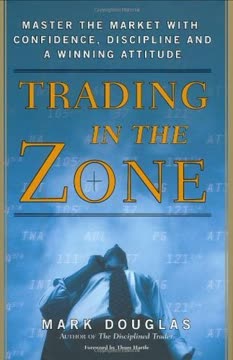Key Takeaways
1. Master the basics of currency trading and market structure
"Currency trading has existed since ancient times and there are references to money changers right back to biblical times."
Historical context. The foreign exchange market has evolved from ancient money changers to a $5.1 trillion daily turnover market. Understanding its structure is crucial:
- Key players: Banks, corporations, hedge funds, central banks, and retail traders
- Currency pairs: Majors (e.g., EURUSD, USDJPY), minors, and exotics
- Quoting conventions: Base and quote currencies, pips, and spreads
Market dynamics. FX is a 24-hour market with varying liquidity and volatility:
- Peak liquidity: During London/New York overlap (11:00AM to 4:00PM London time)
- Important times: Economic data releases, central bank announcements, and fixes (e.g., WMR 4:00PM London fix)
Understanding these basics provides a solid foundation for navigating the complex world of currency trading.
2. Understand fundamental analysis and economic indicators
"The key factor when positioning into a central bank meeting is that you need to have a view that differs from the market."
Economic drivers. Currencies are influenced by a complex interplay of global and domestic factors:
- Global: Growth, commodity prices, risk aversion, geopolitics
- Domestic: Monetary policy, capital flows, trade balance
Key indicators. Successful traders closely monitor:
- Interest rates and central bank policies
- Inflation data (CPI, PCE)
- Employment figures (Nonfarm Payrolls, Unemployment Rate)
- GDP and other growth indicators
Market expectations. The concept of "what's priced in" is crucial. Traders must understand:
- Consensus forecasts vs. actual data
- Central bank forward guidance and market reactions
- "Buy the rumor, sell the fact" phenomenon
By developing a deep understanding of these fundamental factors, traders can form unique views and capitalize on market inefficiencies.
3. Utilize technical analysis for trade timing and risk management
"I believe that technical analysis is a valuable tool but it does not work well as a standalone trade selection or forecasting methodology."
Integrated approach. Technical analysis should be used in conjunction with fundamental and behavioral analysis:
- Support and resistance levels
- Trend identification (moving averages, Parabolic SAR)
- Momentum indicators (RSI, MACD)
- Candlestick patterns
Key setups. Focus on high-probability technical formations:
- Slingshot Reversals
- Deviation from moving averages
- Double and triple tops/bottoms
- Volume spikes at price extremes
Risk management. Use technical levels to:
- Determine entry and exit points
- Set stop losses and take profit levels
- Size positions based on risk-to-reward ratios
By incorporating technical analysis into a broader analytical framework, traders can improve trade timing and risk management while avoiding the pitfalls of relying solely on chart patterns.
4. Exploit intermarket relationships and correlations
"Markets are made up of fallible, irrational human beings with imperfect information."
Cross-asset analysis. Understanding relationships between different markets can provide valuable trading insights:
- Currency pairs vs. interest rate differentials
- Commodity currencies vs. underlying commodity prices (e.g., AUD/USD and gold)
- Equity indices vs. risk-sensitive currencies
Lead-lag relationships. Identify situations where one market leads another:
- Example: DAX (German stock index) movement preceding EURUSD
- Use correlations to confirm trade ideas or identify potential divergences
Adaptive approach. Recognize that correlations change over time:
- Monitor shifts in market regimes and narratives
- Adjust trading strategies as relationships evolve
By developing expertise in intermarket analysis, traders can gain an edge by anticipating currency movements based on related asset classes.
5. Recognize and capitalize on behavioral finance patterns
"Markets populated by algorithms and inexperienced traders will have a propensity toward fatter tails."
Cognitive biases. Understand common psychological pitfalls:
- Confirmation bias: Seeking information that supports existing views
- Overconfidence: Overestimating one's abilities and knowledge
- Loss aversion: Feeling losses more strongly than equivalent gains
Market sentiment. Gauge overall market positioning and emotion:
- Use tools like COT reports and sentiment surveys
- Look for extremes in positioning as potential reversal signals
Contrarian opportunities. Identify situations where crowd behavior creates mispricing:
- Magazine cover indicator: Extreme sentiment reflected in mainstream media
- Overreactions to news events or data releases
By understanding and exploiting behavioral patterns, traders can position themselves to profit from market inefficiencies and avoid common psychological traps.
6. Implement robust risk management and position sizing strategies
"The first priority for every trader is to avoid risk of ruin. Live to trade another day."
Capital preservation. Understand your "free capital" and set appropriate risk limits:
- Define maximum drawdown levels
- Implement daily, weekly, and monthly stop losses
Position sizing. Use a systematic approach based on:
- Conviction level (e.g., 3-star, 4-star, 5-star trades)
- Volatility of the currency pair
- Distance to stop loss
Risk allocation. Balance aggression and caution:
- Increase risk when trading from a position of strength (positive YTD P&L)
- Reduce risk during drawdowns or periods of poor performance
Stop loss discipline. Adhere to predetermined exit points:
- Write down stop losses before entering trades
- Avoid moving stops except for trailing stops to lock in profits
By implementing a robust risk management framework, traders can survive drawdowns and position themselves for long-term success.
7. Develop the mindset and habits of successful traders
"90% of the game is half mental."
Emotional control. Cultivate self-awareness and discipline:
- Recognize and manage emotions like fear, greed, and euphoria
- Implement a consistent daily routine to maintain focus
Independent thinking. Develop your own views while considering diverse perspectives:
- Read extensively but form your own conclusions
- Avoid herd mentality and reflexive contrarianism
Continuous learning. Embrace a growth mindset:
- Adapt to changing market conditions and new information
- Analyze both winning and losing trades for improvement opportunities
Process over outcome. Focus on making good decisions rather than short-term results:
- Understand the role of luck in short-term performance
- Evaluate trades based on adherence to your strategy, not just P&L
By cultivating these mental attributes and habits, traders can develop the resilience and adaptability necessary for long-term success in the challenging world of currency trading.
Last updated:
FAQ
What's The Art of Currency Trading about?
- Comprehensive Guide: The Art of Currency Trading by Brent Donnelly is a detailed guide to the foreign exchange market, offering insights from over 20 years of professional trading experience.
- Fusion Approach: It emphasizes a "fusion approach" that combines technical, fundamental, and behavioral finance analyses with risk management to enhance trading success.
- Practical Techniques: The book provides specific techniques and setups used by Donnelly, equipping readers with actionable strategies to improve their trading performance.
Why should I read The Art of Currency Trading?
- Real-World Experience: Brent Donnelly shares insights grounded in real market experience, making the book valuable for both novice and experienced traders.
- Filling a Gap: It addresses the lack of quality currency trading literature authored by professionals, bridging the gap between theory and practical application.
- Focus on Psychology: The book emphasizes the importance of psychological factors in trading, helping readers manage emotions and maintain discipline for long-term success.
What are the key takeaways of The Art of Currency Trading?
- Market Structure Understanding: The book explains the FX market structure, including participant roles and how liquidity and volatility affect trading.
- Risk Management Techniques: Donnelly highlights strategies for managing risk, such as position sizing and maintaining a trading journal.
- Behavioral Finance Insights: It discusses cognitive biases and market psychology, offering tools to help traders recognize and mitigate their biases.
What is the fusion approach in The Art of Currency Trading?
- Combining Analyses: The fusion approach integrates fundamental, technical, behavioral finance, and risk management analyses for a comprehensive trading strategy.
- High-Probability Setups: It emphasizes identifying "Five-Star trades," where multiple analyses align to indicate high-probability opportunities.
- Adaptability: The approach encourages adapting strategies based on changing market conditions, crucial in the dynamic FX market.
How does The Art of Currency Trading address risk management?
- Position Sizing Strategies: Donnelly stresses determining position size based on capital and risk tolerance, providing methods to avoid overexposure.
- Trading Journal: The book advocates for maintaining a trading journal to track performance and refine strategies over time.
- Stop Loss and Take Profit: It discusses setting clear stop loss and take profit levels to manage risk effectively, protecting capital and locking in profits.
What is the significance of behavioral finance in The Art of Currency Trading?
- Cognitive Biases: The book explores biases like overconfidence and loss aversion, crucial for maintaining objectivity in trading.
- Market Sentiment: Donnelly emphasizes market sentiment's role in price movements, providing insights into potential market reversals.
- Practical Tools: It offers tools like the Skyscraper Indicator to gauge market sentiment, enhancing decision-making and trading outcomes.
What are the Seven Deadly Setups in The Art of Currency Trading?
- Key Trading Patterns: These setups include patterns like the Slingshot Reversal and Extreme Deviation from a Moving Average.
- Reversal and Continuation: They encompass both reversal and continuation patterns, aiding in effective trade entry and exit.
- Practical Application: Each setup is explained with real-life examples, helping traders apply these concepts in their trading.
What is the Slingshot Reversal pattern in The Art of Currency Trading?
- Pattern Definition: It occurs when a significant level is breached but fails to hold, leading to a rapid reversal back into the previous range.
- Psychological Dynamics: The pattern triggers capitulation among traders on the wrong side, creating opportunities for those recognizing the reversal.
- Trading Strategy: Traders should identify a crucial level, wait for a break, and place a stop entry order below the level to capitalize on momentum shifts.
What is the buy the rumor/sell the fact concept in The Art of Currency Trading?
- Market Anticipation: This concept refers to markets pricing in expected events ahead of time, with traders buying in anticipation and selling post-announcement.
- Example in Action: Donnelly illustrates this with the Scottish Referendum, where GBP rallied on polls but reversed after the official announcement.
- Implications for Traders: Understanding this helps anticipate market reactions, emphasizing timing and sentiment in trading decisions.
How does Brent Donnelly suggest managing risk in The Art of Currency Trading?
- Set Clear Stop Losses: Establish stop loss levels before entering a trade to define maximum loss and prevent emotional decisions.
- Dynamic Position Sizing: Adjust position sizes based on confidence levels and market conditions, risking more on high-conviction trades.
- Monthly Risk Assessment: Evaluate performance monthly and adjust risk parameters, maintaining discipline during winning and losing streaks.
What are the common mistakes traders make according to The Art of Currency Trading?
- Poor Risk Management: Many traders lack effective risk management strategies, leading to significant losses.
- Emotional Trading: Emotions often dictate decisions, resulting in impulsive actions and poor outcomes.
- Overtrading: Traders may overtrade due to boredom or FOMO, eroding capital without a clear plan.
What are the best quotes from The Art of Currency Trading and what do they mean?
- “Trading is a lifelong pursuit.”: Emphasizes continuous learning and adaptation in trading, viewing it as an ongoing journey.
- “Adapt or die.”: Stresses the necessity of being flexible and responsive to changing market conditions.
- “Good traders have a plan.”: Highlights the importance of a structured trading plan to stay disciplined and focused.
Review Summary
The Art of Currency Trading is highly praised for its comprehensive coverage of forex trading, market structure, and general trading principles. Readers appreciate the author's practical experience and insights on technical analysis, risk management, and behavioral finance. Many consider it essential reading for forex traders, but also valuable for traders in other markets. While some found certain sections repetitive or basic, most reviewers highlighted its usefulness for both beginners and experienced traders. The book's real-world applications and ability to improve trading strategies were frequently mentioned as strengths.
Similar Books










Download PDF
Download EPUB
.epub digital book format is ideal for reading ebooks on phones, tablets, and e-readers.





